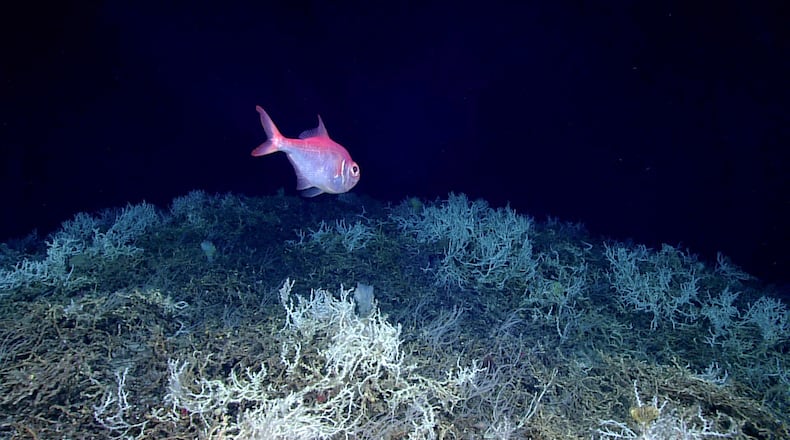Scientists have found the world’s largest-known habitat of deep-sea corals off the Southeast coast and a significant portion lies just 90 miles offshore from Georgia.
The nearly continuous formation covers 6.4 million acres of the sea floor, an area larger than the state of Vermont. It was discovered by a team of researchers from the federal National Oceanic and Atmospheric Administration and other agencies, plus several universities and ocean exploration companies.
The corals were documented during a multi-year mapping campaign of the Blake Plateau, an underwater plain off the U.S.’ East Coast. The findings were published earlier this month in the peer-reviewed journal Geomatics.
The deep-sea corals cover an area that is roughly 310 miles long and 68 miles wide stretching from near Charleston, South Carolina, all the way down to Miami.
Unlike the barrier reefs and atolls favored by snorkelers, the corals off the Southeast coast are in clusters of mounds — the scientists identified 83,908 individual mounds across the study area. And they are located in much deeper water, with formations lying anywhere from a few hundred feet to 3,000 feet below the surface.
Credit: NOAA Ocean Exploration
Credit: NOAA Ocean Exploration
The coral species that live in shallow, tropical waters get their energy from a symbiotic relationship with the photosynthetic algae that live in their polyps. But very little sunlight penetrates hundreds of feet below the surface, making photosynthesis for these Atlantic corals impossible.
Instead, the deep-water species off Georgia’s coast survive by filtering microorganisms from the depths, said Derek Sowers, the mapping operations manager at the nonprofit Ocean Exploration Trust and the study’s lead author.
The colonies are dominated by a species known as Desmophyllum pertusum, which prefers cold water temperatures ranging between 39 and 59 degrees.
The mapping effort involved years of sonar surveys — 31 in all — and 23 submersible dives down to the coral. Sowers said there is still more to learn about this area and other uncharted parts of the world’s oceans. About 75% of the planet’s vast underwater surface remains unmapped.
But for now, the research provides more proof that the Blake Plateau, long-thought to be a barren plain, is full of life. He said researchers observed crabs, sponges, sea stars, lobsters, shrimp and a variety of fish among the corals.
“Because it’s such an important habitat for so many marine organisms, it’s obviously very important for the food chain,” Sowers said. “The whole health and productivity of the ocean off the Southeast U.S. is tied to this area.”
Credit: NOAA Ocean Exploration
Credit: NOAA Ocean Exploration
Other coral structures around the world are in grave danger, mainly from climate change. As the world’s oceans absorb vast amounts of heat, many coral reefs are experiencing deadly “bleaching” events more frequently. The United Nations’ Intergovernmental Panel on Climate Change has warned that if warming is not held in check, between 70% and 90% of coral reefs worldwide could be lost.
Sowers said it’s not yet clear how the deep-water formations his team mapped will be affected, but like other corals, they are vulnerable to changes in temperature and ocean acidity. Sowers added that he hopes the research will inspire policymakers to act.
“If people like to fish and have a healthy ocean, it’s really critical that we protect these habitats from destruction,” he said.
A note of disclosure
This coverage is supported by a partnership with Green South Foundation and Journalism Funding Partners. You can learn more and support our climate reporting by donating at ajc.com/donate/climate/
About the Author
Keep Reading
The Latest
Featured





